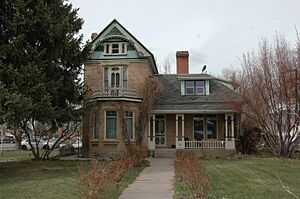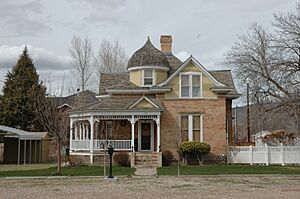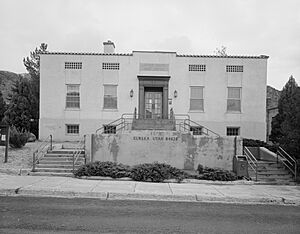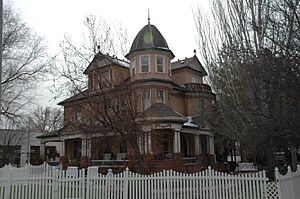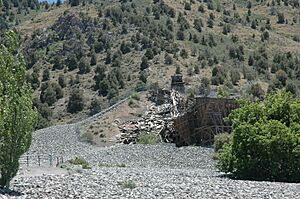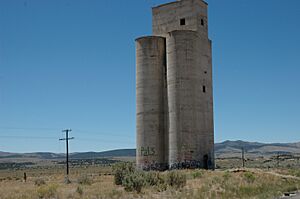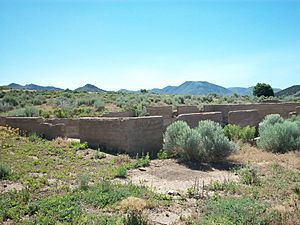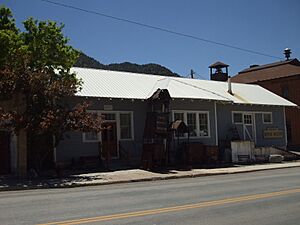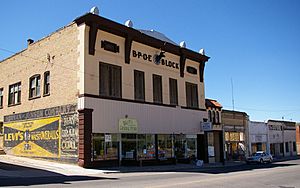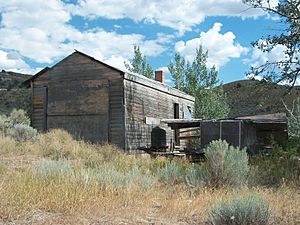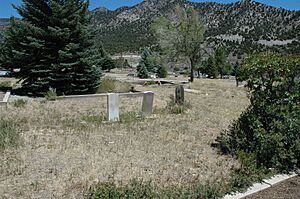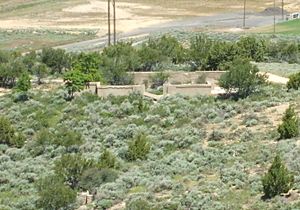National Register of Historic Places listings in Juab County, Utah facts for kids
Have you ever wondered about old buildings and places that are super important to history? In Juab County, Utah, there's a special list of these places called the National Register of Historic Places. It's like a hall of fame for buildings, sites, and objects that tell us amazing stories about the past.
This list helps protect these cool spots so future generations can learn from them too. There are 23 places in Juab County on this list, and one used to be on it but isn't anymore. Let's explore some of these fantastic historic treasures!
Contents
Historic Homes and Buildings
Juab County has several homes and public buildings that are recognized for their history and unique architecture. These places often show us how people lived and worked many years ago.
Edwin Robert Booth House
The Edwin Robert Booth House is located in Nephi. It was added to the National Register in 1979. This house is a great example of the homes built in the area a long time ago.
Oscar M. Booth House
Also in Nephi, the Oscar M. Booth House joined the list in 1983. It's another important historic home that shows the style of buildings from its time.
Juab County Jail
The old Juab County Jail in Nephi was built a long time ago. It was listed in 1987. This building tells us about the justice system and community life in the past.
US Post Office Buildings
Two post offices in Juab County are on the list. The US Post Office-Eureka Main in Eureka and the US Post Office-Nephi Main in Nephi were both added in 1989. These buildings were important centers for communication and community gatherings.
George Carter Whitmore Mansion
The George Carter Whitmore Mansion in Nephi is a grand old house. It was added to the list in 1978. This mansion gives us a peek into the lives of prominent families from the past.
Mining History Sites
Juab County has a rich history of mining, and many of its historic places are connected to this industry. These sites show us how people mined for valuable minerals and the challenges they faced.
Centennial-Eureka Mine
South of Eureka, the Centennial-Eureka Mine was listed in 1979. This mine played a big role in the area's mining boom.
Eagle and Blue Bell Mine
Another important mine near Eureka is the Eagle and Blue Bell Mine, also listed in 1979. Mines like these were central to the economy and growth of towns like Eureka.
Grand Central Mine
The Grand Central Mine is located north of Mammoth. It was added to the list in 1979. This mine, like others, helped shape the landscape and communities of Juab County.
Knight Grain Elevator
Near Eureka, the Knight Grain Elevator was listed in 1979. While not a mine itself, grain elevators were important for storing and moving goods, including those needed for mining operations.
Showers Mine and Headframe
Southeast of Mammoth, the Showers Mine and Headframe was recognized in 1979. A headframe is a structure built over a mine shaft, used for hoisting materials and miners in and out of the mine.
Sunbeam Mine
East of Silver City, the Sunbeam Mine was listed in 1979. This mine contributed to the mining activity in the Silver City area.
Tintic Smelter Site
The Tintic Smelter Site near Silver City was added to the list in 1979. A smelter is a place where raw ore from mines is processed to extract valuable metals. This site shows the industrial side of mining.
Union Pacific Railroad Depot
The Union Pacific Railroad Depot in Eureka was listed in 1979. This train station was originally built in Eureka, then moved to Silver City, and later moved back to Eureka. It now houses the Tintic Mining Museum. Railroads were vital for transporting mined materials and supplies.
Historic Districts
A "historic district" is an area that contains a group of buildings, structures, or sites that are historically or architecturally important. They tell a bigger story about a town or a specific time period.
Eureka Historic District
The Eureka Historic District covers much of the city of Eureka. It was listed in 1979. This district includes many buildings that show what Eureka was like during its mining boom.
Mammoth Historic District
The Mammoth Historic District covers the city limits of Mammoth. It was added to the list in 1979. This district helps preserve the unique character of Mammoth, another town shaped by mining.
Cemeteries and Archeological Sites
Some historic places are not buildings but important sites like cemeteries or ancient archeological areas. These places give us clues about the people who lived here long ago.
Diamond Cemetery
South of Mammoth, the Diamond Cemetery was listed in 1979. Cemeteries often provide insights into the lives and communities of the past.
Eureka City Cemetery
The Eureka City Cemetery is southwest of Eureka. It was added to the list in 1979. This cemetery is another important historical record for the town.
Fitch Cemetery
The Fitch Cemetery near Eureka was listed in 1979. These old cemeteries are quiet places that hold many stories.
Knightsville School Foundation
East of Eureka, the Knightsville School Foundation was listed in 1979. This site is the remains of a school from the old mining town of Knightsville, showing where children learned in the past.
Silver City Cemetery
The Silver City Cemetery is southwest of Mammoth, near Silver City. It was added to the list in 1979.
Fish Springs Caves Archeological District
The Fish Springs Caves Archeological District near Callao was listed in 1981. The exact location of this site is kept private to protect its ancient treasures. Archeological sites like this can contain artifacts and evidence of very old human activity.
Nephi Mounds
The Nephi Mounds near Nephi were added to the list in 1975. Like the Fish Springs Caves, the exact location of these mounds is restricted to protect them. These sites are important for understanding ancient cultures that lived in the area.
Former Listing
Sometimes, a place is removed from the National Register. This can happen if it's destroyed, or if it no longer meets the requirements.
South Iron Blossom Headframe
The South Iron Blossom Headframe was located southeast of Mammoth. It was listed in 1979 but was removed from the list in 1991.



